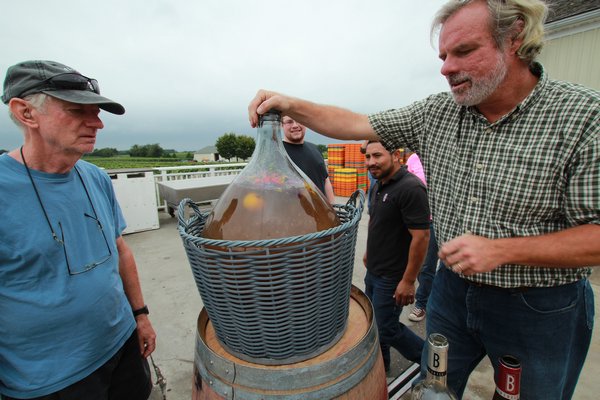
While roaming around on Facebook recently to see what the wineries were up to during harvest, I was stopped in my tracks by an image from Bedell Cellars’ timeline. In it, winemaker Richard Olsen-Harbich is shown with his hand firmly atop a glass carboy that’s filled with newly-pressed grape juice, a yeast-breeding “starter” for this vintage’s fermentations. Floating in the juice were colorful fruits and flowers. Clearly this was not your standard yeast culture.When I asked Rich to explain what was in the brew, he told me, “Every year we ask everyone [on Bedell’s staff] to find something native to bring in and add to the culture. Items include flowers, seashells, rocks, soil and water from our surrounding beaches. We even have a local native arrowhead that we use in the starter every year. It’s both fun and very spiritual and our culture truly becomes something even more than just an indigenous fermentation. It becomes something of the essence of the North Fork and it’s something that is in every wine we make.”
This ceremonial starter is a far cry from the way most modern commercial wineries today encourage their wines to begin fermentation. Everyone needs yeast to convert the sugar in the grapes to alcohol, but the native or indigenous yeasts actually in the vineyard are not always the most reliable ones to make a successful fermentation.
In a centuries-old winemaking region like Burgundy or Tuscany, the local yeasty beasties have had a long time to evolve into wine-appropriate types, but in a region like eastern Long Island where the commonest pre-1970s fermented food was sauerkraut, relying on the native micro-flora could be risky business. As for the addition of totems like seashells and arrowheads, well, that hearkens back to far more ancient sentiments about fermentation.
Until the 1860s, when Louis Pasteur identified yeast as the agent causing grape juice to turn into wine, fermentation was regarded as a manifestation of God’s own spontaneous generation. If wine wouldn’t ferment, or turned to vinegar, well, maybe God wanted to punish the winemaker.
Although Pasteur clearly demonstrated the role of microorganisms in fermentation, many insisted that winemaking was a form of magic. Even today, the idea of wines made by “wild” yeast carries a mystical cachet. Although there is no legal definition of “wild yeast” or of “natural” winemaking, and cultured yeast are all derived from naturally-occurring sources, reliance on indigenous yeast (those already in the vineyard environment) is increasingly popular.
That said, when it comes to yeast, most modern wineries have, at some point, used commercially-purchased, cultured yeast, specifically for the purpose of initiating and managing the fermentation by having huge numbers of a chosen strain available from the onset of fermentation. Once used, those organisms persist in the environment, probably in more potent numbers than any indigenous yeast brought in on the fruit.
Commercially cultured, freeze-dried yeast (which looks like the yeast you’d buy to make bread) is primarily some variant of saccharomyces cerevisiae, selected in traditional winemaking regions for specific traits like tolerance to high alcohol or aromatic ester enhancement. Today, the choices are extensive (Scott Laboratories offers over 36 yeast variants, for example) and include “exotics” like torulaspora delbrueckii (“biodiva”) intended to mimic “wild” yeast fermentation, but under controlled conditions.
Although most winemakers still prefer to work with the predictability of cultured yeast, Olsen-Harbich told me that he has experimented with indigenous yeast since 1983, and relied on it exclusively since 2008. He doesn’t see it as risky. While acknowledging the presence of some “cultured” type yeasts in the winery from earlier vintages, he explained, “The most important factor is the effect of the non-saccharomyces yeast strains that dominate the must in its early stages. These yeasts, like hanseniaspora and Candida strains start growing in the juice very early on and have also been found to remain right through to the end of fermentation. A winery that uses nothing but indigenous yeast also begins to develop its own natural flora that is exclusive to the estate. So in essence we are allowing our own designer yeast strains to develop—from our vineyard as well as in our building and on our equipment.”
Applying this idea of a terroir-driven yeast to local cuisine, Bedell has propagated its starter for Peter Endriss, the head baker at Manhattan’s Runner & Stone. He’s made bread with it, including sourdough loaves and focaccia topped with Bedell’s Riesling grapes.
Terroir-driven bread and wine? There’s some delicious magic.